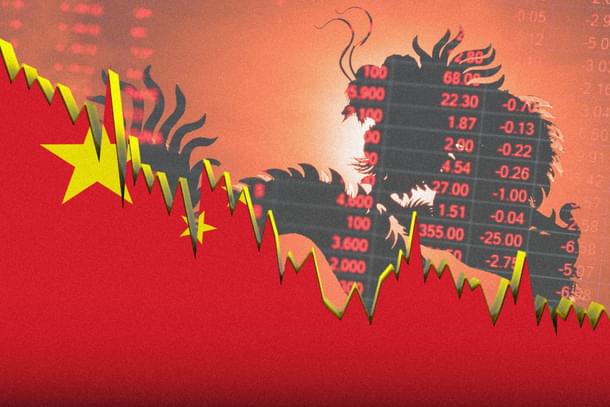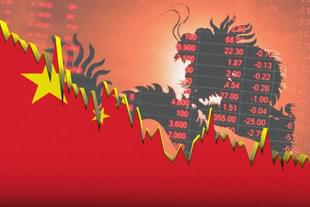Economy
China’s Deep Economic Crisis — And A Trade War It Can’t Win
Prof. Vidhu Shekhar
Apr 11, 2025, 11:10 AM | Updated 01:55 PM IST
Save & read from anywhere!
Bookmark stories for easy access on any device or the Swarajya app.


China’s economy is unravelling — not through a sudden crash, but by slow, systemic suffocation. Beneath the façade of 5% growth lies mounting debt and entrenched deflation. The deeper danger isn't immediate collapse but a prolonged zombie-like stagnation that spreads risks across the global economy.
In late 2024, China announced that its economy grew by 5% for the year. At first glance, this seemed like good news. The world’s second-largest economy appeared stable and a working engine in uncertain times.
But behind the headlines, the reality is very different. Foreign investors are pulling out. Youth unemployment is rising fast. Big real estate companies are collapsing. And prices, both at factories and in shops, are steadily falling.
What’s going wrong?
A Growth Story That No Longer Adds Up
While the double-digit growth era is far gone, China’s leaders have kept their aim fixed at a 5% annual growth rate. A fair number for the size of the Chinese economy, 5% growth has become a political priority.
But the actual economic activity that people feel — in terms of wages, prices, and business earnings — tells a different story.
What is further interesting to note is that in 2024, China’s nominal GDP grew just 4.2%, as against the real GDP growth of 5%. Typically, nominal GDP grows faster than real GDP because it includes inflation.
Here, a lower nominal GDP suggests that prices are falling across the board, signalling what is known as deflation — something that economists fear much more than inflation, for it represents an utterly stagnating economy.
Further to this, independent groups like the Rhodium Group estimate that China’s real growth has likely been between 2.4% and 2.8%, far lower than the official number. And that is with significant government support behind the scenes.
In short, the headline number may look okay, but the economy underneath is slowing down and is deeply stressed.
An Economy Stuck: Spiral of Debt, Overcapacity, and Declining Confidence
China’s rapid growth over the past two decades was powered by aggressive borrowing across all segments — households, companies, and local governments. But now, the weight of that debt is choking the system.
Households owe between 60–64% of GDP, mainly in mortgages. But home prices have fallen for 20 straight months, and many families are seeing the value of their biggest asset decline.
With loan EMIs eating up over half of many families’ monthly income, there’s little room left for spending. That makes any serious revival in consumption, a key government priority, extremely difficult.
Corporate debt levels are even higher, ranging from 123% to 172% of GDP. A significant share is concentrated in Local Government Financing Vehicles (LGFVs), which are opaque entities that funded the infrastructure boom.
These vehicles are deeply in debt and, in many cases, insolvent. But letting them fail risks local banking crises, while bailing them out deepens the national debt burden.
China now finds itself in a debt trap: too leveraged to grow fast, too fragile to clean up the mess.
Meanwhile, years of industrial investment have created massive overcapacity, especially in sectors like electric vehicles, solar panels, steel, and semiconductors.
In many cases, production exceeds not just domestic needs but global demand itself. Factories keep running because shutting them down would result in sunk fixed costs and trigger layoffs and social issues.
But this continued output is worsening a deflationary spiral: prices are falling, profits are vanishing, and demand is shrinking. Producer prices have declined for more than a year, and consumer prices fell 0.7% in February 2025.
The property market, long the engine of Chinese household wealth, is also now a liability. Developers like Evergrande and Country Garden have defaulted, leaving banks exposed to severe bad loans.
Construction has slowed sharply. Land sales, a key source of local government revenue, have dried up, compounding fiscal strain.
This downturn is especially harsh on the younger generation. Youth unemployment stands officially at 16.9%, but estimates run far higher, especially in cities.
Many young, educated Chinese have joined the ranks of the so-called “professional children” — adults who live with and depend on their parents, unable to find jobs or build independent lives.
What was once a confident, aspirational generation is now marked by disillusionment and social withdrawal.
This is not a cyclical downturn. It is a structural slowdown, with debt, deflation, overcapacity, and joblessness reinforcing one another. The machine has not crashed but is seizing up in slow motion.
Policy Fatigue: Why the Old Tools Do Not Work Anymore
Beijing has responded with familiar tools — rate cuts, liquidity injections, and infrastructure stimulus — but none are working as they once did.
The People’s Bank of China has eased its policy, cutting interest rates and reserve requirements. However, with households and firms already overleveraged, monetary policy has lost traction.
Banks are cautious. Borrowers are hesitant. Cheaper credit is no longer translating into economic momentum.
Fear of runaway inflation has kept fiscal stimulus largely focused on supply-side spending and infrastructure and industrial upgrades. Direct support to households, which could possibly revive demand — albeit at the cost of inflation — remains minimal.
Local governments are effectively immobilized. Saddled with debt and falling land revenues, they are scaling back services and lack the capacity to support recovery. Their paralysis has become a major drag on national policy execution.
Across the economy, developers are insolvent, consumers are cautious, and private investment is subdued. Every channel that might transmit stimulus — banking, local government, household consumption — is blocked or compromised.
The leadership now faces a structural dilemma: inflate the debt bubble further to preserve stability or allow defaults and risk contagion. So far, it has chosen a third path — incremental containment, which avoids crisis but also defers resolution.
The problem is not that policy tools are gone. It is that they no longer work under current conditions. Interest rate cuts do not spark borrowing. Infrastructure spending does not lift consumption.
What remains is policy inertia and the quiet normalization of stagnation.
A Trade War at the Worst Time
Just as China wrestles with deflation, overcapacity, and crumbling confidence, the U.S. has reignited a trade war.
President Trump’s 2025 “reciprocal tariff” regime may echo 2018, but the global context has completely changed. Back then, tariffs sparked fears of inflation. Today, they weaponize deflation. And in a deflationary world, tariffs don’t raise prices; they crush the weakest supplier.
With factories running far above demand and prices already falling, Chinese exporters have no leverage. Their pricing power is gone, and their negotiating position is desperate. To stay afloat, they would even be willing to absorb the cost of tariffs through deeper discounts, squeezed profits, or a weaker yuan.
Beijing, meanwhile, has few viable counters. It imports too little from the U.S. to retaliate meaningfully. Currency devaluation risks capital flight.
Threatening export bans — such as of rare earths and pharma inputs — will further accelerate global diversification. While they are still projecting strength, it masks a shrinking toolbox.
This is a trade war China cannot afford and cannot win. The timing could not have been worse.
The World with China in Crisis
China’s economic crisis is not a story of sudden collapse. It is a slow-burning structural unraveling.
A high-debt, deflation-prone, demographically aging, and policy-constrained economy can no longer rely on the tools that once delivered breakneck growth.
The engine is running, but the transmission is broken. Output exists, but momentum is gone.
The deeper danger lies not in volatility but in stagnation that drags on, is difficult to reverse, is resistant to reform, and is increasingly visible on the world stage.
China's problems are already shaping global trade patterns, supply chain shifts, capital flows, and commodity demand. Its inability to revive domestic consumption or contain financial risks now poses a global threat.
The world once feared a relentlessly rising China. It must now contend with a fragile, inward-looking, and financially constrained one. And fragility at this scale, in the world’s second-largest economy, does not stay isolated.
The China boom changed the world. The Chinese structural slowdown will as well — just in more uncertain and uneven ways.
Dr. Vidhu Shekhar holds a Ph.D. in Economics from IIM Calcutta, an MBA from IIM Calcutta, and a B.Tech from IIT Kharagpur. He is currently an Assistant Professor in Finance & Economics at Bhavan's SPJIMR, Mumbai. Previously, he has worked as an investment banker and hedge fund analyst. Views expressed are personal.





